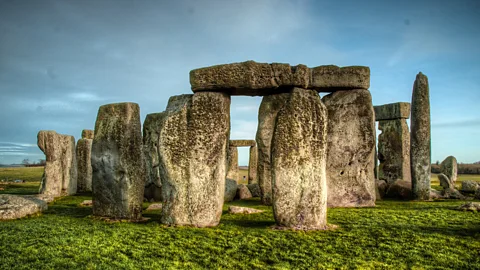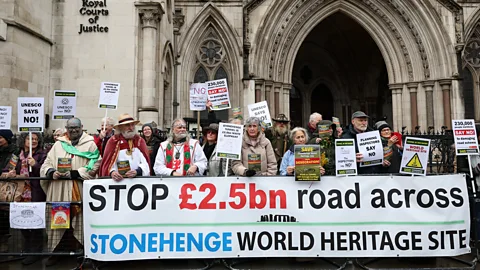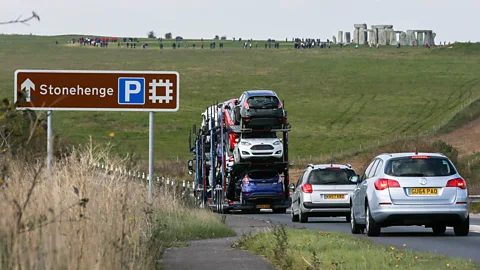Will Stonehenge lose its Unesco World Heritage status?
 Kevin A Scherer/Getty Images
Kevin A Scherer/Getty ImagesPlans to build a road tunnel under Stonehenge have once again come to the fore, paving the way for one of the UK's most controversial construction projects in living memory.
On 20 March each year, people from all walks of life gather at Stonehenge to see the sun rise on the spring equinox. But this year, even before the first rays of the vernal dawn had struck the famous standing stones, a shadow was hanging over proceedings.
A month earlier, in February 2024, a High Court judge had rejected a legal challenge against plans to build a road tunnel under the World Heritage site in Wiltshire, south-west England, paving the way for one of the UK's most controversial construction projects in living memory.
"It was a dark day for the UK," said John Adams, chairman of the Stonehenge Alliance, a group that campaigns against the tunnel project. "Imagine if we heard they were going to build a bypass over the Egyptian pyramids or a flyover across one corner of the Gardens of Versailles? We'd think it was extraordinary."
This is a long-running saga, the tunnel first having been proposed in the mid-1990s. Since then, estimated costs have surged as high as £2.5bn. The UK's National Highways agency say the tunnel will ease congestion on the traffic-choked A303 road, which passes by Stonehenge and currently offers drivers a famous view of the stones. The main highway will be moved underground and slightly further away from the stones than the current road, which will be replaced by a public right of way open to walkers, cyclists and horse-riders. National Highways say this will improve the visitor experience, by returning "the Stonehenge landscape to something like its original setting".
However, Unesco have condemned the plan on the basis that the proposed tunnel encroaches significantly on the World Heritage Site area that surrounds Stonehenge and is a significant and largely unexcavated archaeological landscape. They have threatened to place Stonehenge on the World Heritage in Danger list, which is the first step towards being delisted as a World Heritage site altogether. "There have only ever been three World Heritage sites delisted," Adams said, "and the UK's got one already – the Liverpool Maritime Mercantile City, which lost its status in 2021. If Stonehenge were to be delisted as well, it would be an international embarrassment."
 Adrian Dennis/Getty Images
Adrian Dennis/Getty ImagesPrestige aside, there are grave concerns about the more tangible consequences of ploughing a tunnel through a World Heritage site. "From an archaeological point of view, there are serious issues," said Professor Mike Parker Pearson, an archaeologist at University College London and a leading authority on Stonehenge. "The area which the tunnel will go through was part of a very dense and large settlement dating from the later period in which Stonehenge was built; quite possibly where the builders themselves would have actually lived," he said. "An estimated half a million artefacts will be removed without record and dumped somewhere else within the rebuilt highway. It's not only a great loss for us in the present, but it's misleading for any archaeologists who might dig this stuff up in the future."
Environmentalist groups like Friends of the Earth are concerned about the significant damage that the building project will cause to wildlife and their habitats. There are also people, particularly members of the Pagan community, for whom Stonehenge is a sacred site, and who fear that the tunnel project could desecrate the landscape. "[The] loss of harmony, energy connections and tranquillity will affect and inhibit peaceful enjoyment of communing in a sacred manner and expressing reverence, respect and honouring of Higher Spirits and ancestors," wrote Archdruid Lois Lloyd in a 2019 letter to the British government.
Honouring the ancestors is one thing, but there's a large community of people in the vicinity of Stonehenge whose quality of life is being severely diminished by the traffic congestion on the current road. I grew up in Wiltshire, a half-hour drive from Stonehenge, and have experienced the interminable traffic jams on the A303. This road is one of the main arteries between London, Devon and Cornwall, so the traffic has a significant impact on tourism and trade for the West Country as a whole.
As a youth, I believed a local piece of received wisdom: that a large part of the reason for the traffic on the road was because people were slowing down to look at the stones. But this is wrong, according to Janice Hassett, founder of the Stonehenge Traffic Action Group.
 Matt Cardy/Getty Images
Matt Cardy/Getty Images"The road's too narrow – it's not a question of people slowing down to look at the stones," she said. "The road finds its way into Shrewton [the nearest village], where it was measured that in a single month, 169,000 vehicles used an entrance 8m wide. Pedestrians are having to control traffic themselves, putting their hands up to cross the road.
More like this:
• An immense mystery older than Stonehenge
"You have to plan your whole life around the road – when I lived in Shrewton I could only go to the supermarket on Tuesdays, because that was the quietest day for traffic."
Stonehenge is just one part of an extraordinarily rich prehistoric landscape that once would have included structures in both stone and wood. Among Parker Pearson's celebrated body of work about the area is the theory that the ephemeral wooden structures, which have long since decomposed, had some ritual use associated with the living, while those destined to survive the millennia – those built in stone – were connected with the dead.
Now, 4,500 years later, that same duality continues to dominate the conversation around Stonehenge – how to honour heritage while also making allowances for the living present.
"There needs to be a balance," Hassett said, "between the living and the dead."
--
If you liked this story, sign up for The Essential List newsletter – a handpicked selection of features, videos and can't-miss news delivered to your inbox every Friday.
